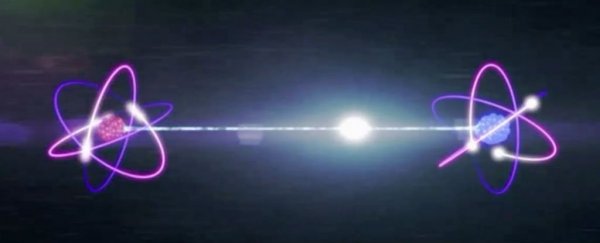Once derided by Einstein himself as "spooky action at a distance", quantum entanglement is a strange phenomenon where two quantum particles interact in such a way that they become deeply linked, and essentially 'share' an existence.
This means that what happens to one particle will directly and instantaneously affect the other - even if it's many light-years away. It sounds nuts, but quantum entanglement is actually being used in labs all over the world right now, and physicists in China just smashed the current record for how many photons (or light particles) can become entangled.
Once thought of as a rare occurrence, and limited to discussions about what the hell happens to matter as it falls over the event horizon of a black hole - spoiler: we still don't know - quantum entanglement has in recent years become a mainstay for physicists working on everything from cryptography to teleportation.
What's arguably the most exciting application of quantum entanglement right now is quantum computing - a technology that's expected to change everything about how we process and store information in the future.
Consider this: Google's new ' quantum computer' is already 100 million times faster than your laptop, and it's not even a proper quantum computer.
Physicists have gotten pretty good at entangling photons in the lab - so much so, that this team in the US is figuring out how to recruit human volunteers to 'see' it with the naked eye. But there's a limit to how many can be entangled at a time.
As MIT Technology Review reports, until recently, the limit to how many photons could be entangled at a time was a mere eight, and this entanglement event could only be produced at a rate of about nine events per hour.
If we want to prove once and for all that quantum computers and quantum teleportation are viable technologies for the future, we're going to have to produce entanglement at a much quicker rate, and involving a whole lot more photons.
Fortunately, that's what a team from the University of Science and Technology of China in Hefei has claimed to do.
"Today, they announce that they've produced 10-photon entanglement for the first time, and they've done it at a count rate that is three orders of magnitude higher than anything possible until now," says Technology Review.
So how did they do it? The researchers, led by physicist Xi-Lin Wang, figured out how to overcome the main obstacle when it comes to entangling photons using a process known as spontaneous parametric down conversion.
Basically, if you want to produce entangled photons, you need to take one energetic photon, and using a laser, split it into two photons with a lower charge inside a crystal of beta-barium borate. These two photons will come out naturally entangled with each other.
To create something like an eight-photon entanglement - or a record-breaking 10-photon entanglement - you can feed them through beam splitters and have them arrive at exactly the same time, which allows you to combine entangled pairs.
To produce more and more entangled pairs, you need to keep zapping the crystal, but the problem is you're only going to be successful in about one in every trillion attempts. And then you have to make sure you actually collect the ones you do produce.
"That's no easy task," Tech Review explains, "not least because the photons come out of the crystal in slightly different directions, neither of which can be easily predicted. Physicists collect the photons from the two points where they are most likely to appear, but most of the entangled photons are lost."
There has to be a better way, right? Right.
Wang's team figured out a way around this problem by limiting the number of directions that these entangled daughter photons can fly off, by controlling the shape of the photon beams.
They've not only increased the number of entangled pairs that can be collected by doing this, but they've coupled this new technique with a 10 million per watt of laser power, which enables more photons to be entangled at a time.
"We demonstrate, for the first time, genuine and distillable entanglement of 10 single photons," say the researchers in their paper, published on pre-print website arXiv.org.
It's important to note that the study has been published online prior to being peer-reviewed for a journal, so the record will need to be independently confirmed.
But once it's made official, this new, more efficient process of producing connected quantum entangled pairs could be rolled out to labs all over the world, and help us figure out once and for all if quantum computers really are all they're cracked up to be.
